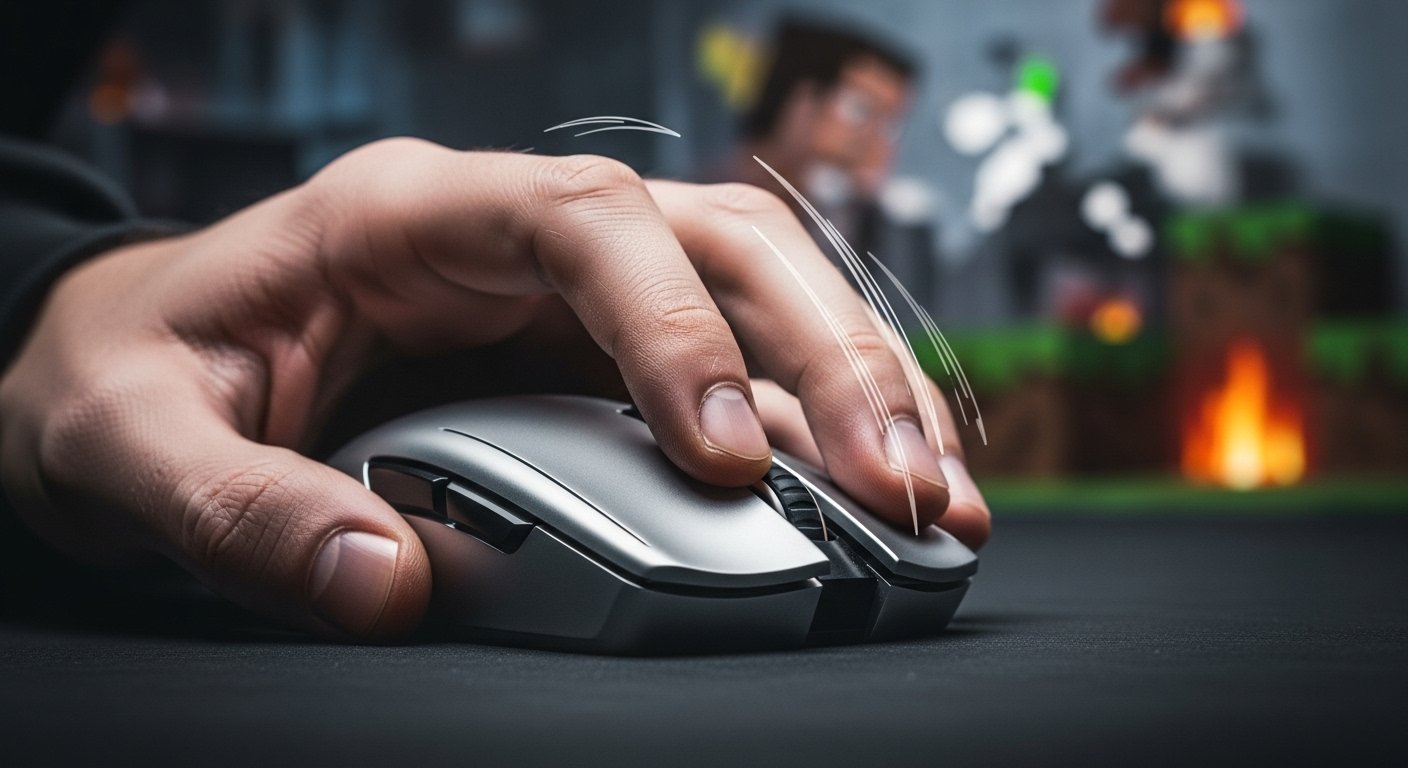The pressure is immense. It’s the final two players in a heated Minecraft duel. You land a solid first hit, but then something changes. Your opponent unleashes a flurry of attacks so fast it feels like they’re hitting you twice for every one of your swings. You hear a distinct, rapid thump-thump-thump-thump sound, a relentless drumming that melts your health bar in seconds. You’ve just been out-clicked by a player using one of the most effective speed techniques in gaming. This guide will teach you how to master that very skill. This is your complete introduction to butterfly clicking, a learnable method that can dramatically increase your Clicks Per Second (CPS) and give you a powerful advantage in any click-intensive game.
This is not just another basic overview. This is your comprehensive training manual. We will break down the exact two-finger technique needed to produce staggering click speeds, often reaching 15, 20, or even more CPS. You will learn which specific types of gaming mice are best suited for this method and why. We will walk you through a step-by-step practice plan, complete with drills to build your muscle memory and consistency. Before you even begin, it’s a great idea to establish a baseline by using a CPS test for 5 seconds to see your current speed. By the end of this guide, you will not only understand the theory behind butterfly clicking; you will have a clear, safe, and effective roadmap to making it a part of your own gaming arsenal.
What is Butterfly Clicking, Really?
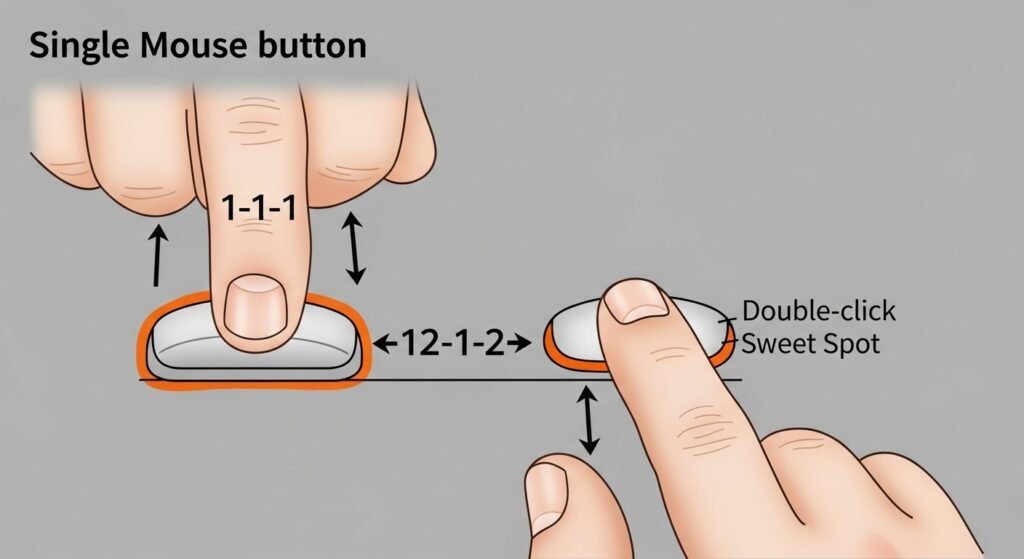
Butterfly clicking is a high-speed clicking method where you use two fingers, usually your index and middle finger, to rapidly tap or drum on a single mouse button. This alternating motion allows each finger to have a micro-second of rest while the other clicks, creating a fluid rhythm that can achieve a Clicks Per Second (CPS) rate far higher than what’s possible with traditional single-finger clicking. It’s a technique that turns your hand into a small, efficient machine.
The Two-Finger Drum: How Alternating Clicks Creates Insane Speed
Imagine trying to drum on a table with just one finger. You can go pretty fast, but you’ll eventually hit a physical speed limit set by how quickly you can lift and press that single finger. Now, imagine drumming with two fingers, alternating between them. You can go dramatically faster because one finger is already moving down while the other is lifting up.
This is the exact principle behind butterfly clicking. By creating a steady, 1-2-1-2 rhythm with your index and middle fingers on the edge of the mouse button, you eliminate the “reset” time of a single finger. The goal isn’t to slam your fingers down but to create a light, consistent drumming motion. This turns a series of distinct actions into one continuous, high-frequency output, which you can measure using a simple click counter.
The “Double-Click” Effect: Friend or Foe?
Here’s where butterfly clicking gets interesting and a bit controversial. Because you are hitting the switch with two different fingers from slightly different angles, you can sometimes cause the switch to “double-click” unintentionally. Some gaming mice, particularly those with sensitive mechanical switches, are prone to registering two clicks from a single, slightly vibrating press. For a butterfly clicker, this isn’t a bug; it’s a feature that amplifies their CPS. This is why dedicated players will often put a new mouse through an ultimate double-click test to see how easily it can produce these extra clicks. While this can boost your speed, it can also make your mouse difficult to use for everyday tasks and may be flagged by some anti-cheat software.
A Personal Confession: The Awkward Mistake I Made for a Full Week
When I first started, I thought butterfly clicking was about force. I would hammer my two fingers onto my poor mouse button as hard and fast as possible. The result? My hand would cramp up after just 30 seconds, my aim was all over the screen, and my CPS was barely higher than my normal clicking speed. I was convinced I just wasn’t built for it. It wasn’t until I watched a slow-motion video of a pro player that I saw my mistake. Their fingers were completely relaxed and barely seemed to lift off the button at all. The secret was finesse, not force. The moment I stopped trying to brutalize my mouse and focused on a light, rhythmic drumming motion, everything changed. My speed shot up, the pain disappeared, and the technique finally started to feel natural.
Is This High-CPS Technique Right for You?
Just because a technique is powerful doesn’t mean it’s the right choice for every player. Butterfly clicking is a highly specialized skill with a unique set of demands and risks. Before you invest hours into mastering this two-finger rhythm, you need to honestly assess if it aligns with your goals, your playstyle, and even your physical health. Choosing the wrong clicking style can lead to frustration, wasted time, and even injury.
The Ideal Candidate: Who Should Learn to Butterfly Click
This method is not for the casual player. It’s a competitive technique for those who are serious about gaining an edge. You are a perfect candidate to learn butterfly clicking if:
- You play click-intensive games. If you’re a dedicated Minecraft PvP player, especially in modes like Bedwars or Skywars, the high CPS from this method can be a game-changer.
- You’ve hit a speed wall. If you’ve maxed out your normal clicking speed and feel like it’s holding you back, butterfly clicking offers a clear path to a higher performance ceiling.
- You have medium to large hands. The technique requires comfortably placing two fingers on a single mouse button, which can be awkward for players with smaller hands.
- You are patient. Learning the rhythm and building the muscle memory takes time. This is a skill you develop over weeks, not hours.
The Warning Label: Who Should Absolutely Avoid It
This is the most important part of this guide. Your health is more important than any in-game advantage. You should absolutely avoid this technique if:
- You have any history of hand or wrist pain. If you’ve ever dealt with conditions like Carpal Tunnel Syndrome, Repetitive Strain Injury (RSI), or tendonitis, do not attempt this. The rapid, repetitive motion can aggravate these conditions severely. For more information on these risks, authoritative sources like the Mayo Clinic provide in-depth explanations of RSI symptoms.
- You feel any sharp pain while practicing. Muscle fatigue is normal, but sharp, shooting, or aching pain is your body’s stop sign. Listen to it.
- You are a casual gamer. The physical strain and the risk of damaging your mouse aren’t worth the slight advantage in non-competitive play.
Butterfly Clicking vs. Jitter Clicking: A Quick Comparison
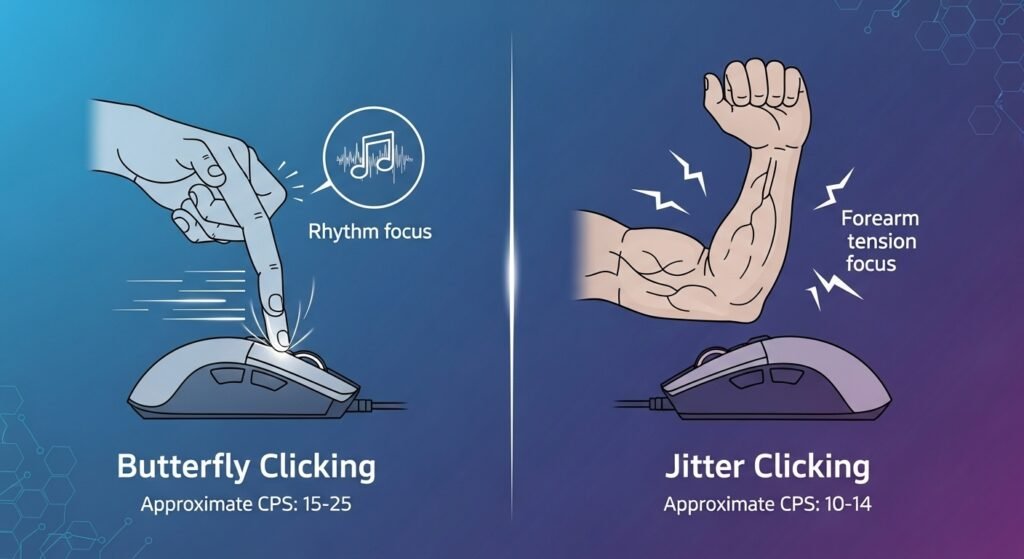
Many players wonder how this technique stacks up against its main rival, jitter clicking. Here’s a quick breakdown:
- Butterfly Clicking: Relies on a two-finger drumming rhythm. It can achieve a higher maximum CPS (often 15-25+) but can make aiming more difficult due to the hand motion. It is also much harder on your mouse’s switches.
- Jitter Clicking: Relies on tensing your arm muscles to create a rapid vibration. It generally has a slightly lower CPS ceiling (around 12-18) but allows for more stable mouse control and better aim. It puts more strain on your arm muscles rather than your fingers.
The best way to feel the difference is to try them. You can measure your potential with a jitter click test for 10 seconds and compare that score to your early butterfly attempts. For most players, one will feel more natural than the other.
The Essential Gear: Why Your Mouse Matters More Than You Think
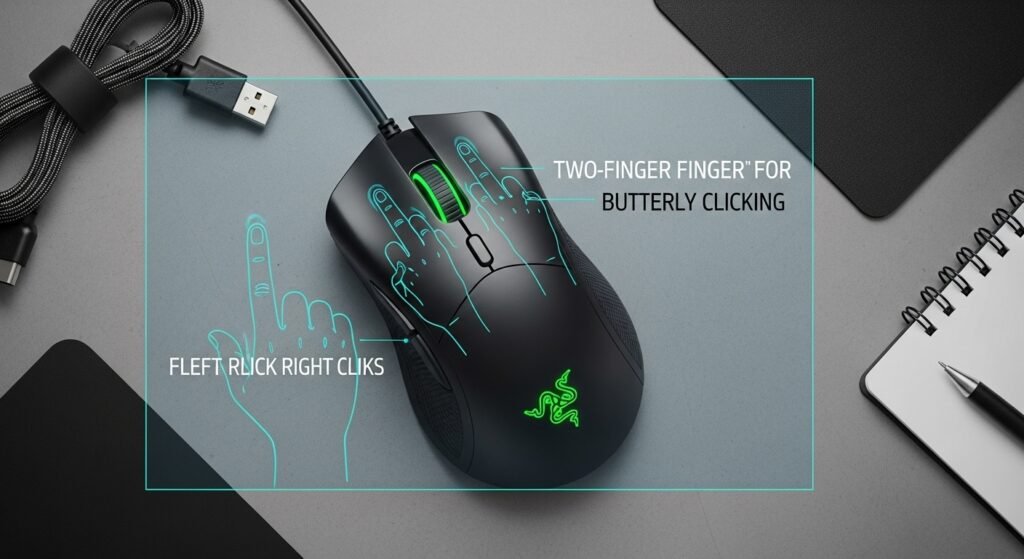
You cannot master butterfly clicking with just any old mouse. This technique puts unique demands on your hardware, and using the wrong equipment will lead to frustration, low speed, and a broken mouse. While skill is important, the truth is that your choice of a gaming mouse is a massive factor in your success. Think of it as choosing the right shoes for a race; the right pair can make you faster and more comfortable, while the wrong pair will just hold you back.
The Switch Factor: Why Some Mice Double-Click Easily (and Why That’s Good)
The heart of a great butterfly clicking mouse is its switches—the tiny mechanical components under the main buttons. As we mentioned earlier, some switches are prone to “double-clicking.” This happens because the mechanical parts inside can chatter or bounce when a click is released, sending a second signal. For butterfly clicking, this is a massive advantage. The two-finger drumming motion naturally creates vibrations that can trigger these double clicks, effectively multiplying your CPS.
Mice with low-debounce delay settings and specific mechanical switches (like some Omron or Kailh models) are famous for this behavior. This is why a key step for many players is to find a mouse that performs well on an ultimate double-click test; if a mouse can double-click easily, it’s likely a great candidate for this technique.
Top 3 Recommended Mice for Butterfly Clicking
While many mice can work, a few models are legendary in the community for their shape, switch type, and overall performance with this specific technique.
- Glorious Model O/D: This is often considered the undisputed champion. Its lightweight design reduces fatigue, and its software allows you to set the debounce time to its lowest setting, making it incredibly receptive to double-clicks. The matte surface also provides excellent grip for your fingers.
- Razer DeathAdder Series: A classic for a reason. The DeathAdder has a wide, ergonomic shape that is perfect for comfortably fitting two fingers on the main button. While newer models use optical switches that don’t double-click, older versions (like the Elite) with mechanical switches are highly sought after by butterfly clickers. You can find detailed breakdowns of its ergonomic design on authoritative hardware sites like TechRadar’s review section.
- Logitech G Pro Wireless/Superlight: While a premium option, its ambidextrous and safe shape provides a great platform for the technique. Its switches are known for being light and spammable, which is ideal for the rapid drumming motion required.
The Overlooked Factor: Why a Wide Mouse Shape is Crucial
The single biggest ergonomic challenge of butterfly clicking is fitting two adult-sized fingers onto one button without feeling cramped. A small, narrow mouse makes this incredibly awkward and can lead to hand strain.
You want to look for a mouse with wide main buttons and a shape that allows your ring and pinky fingers to rest comfortably on the side. This provides the stability your hand needs while your other two fingers do the rapid work. An uncomfortable grip will cause you to tense up, which kills your speed and stamina. A wide, comfortable mouse allows your hand to stay relaxed, which is the true secret to achieving a high and consistent click speed.
How to Butterfly Click: A Step-by-Step Beginner’s Method
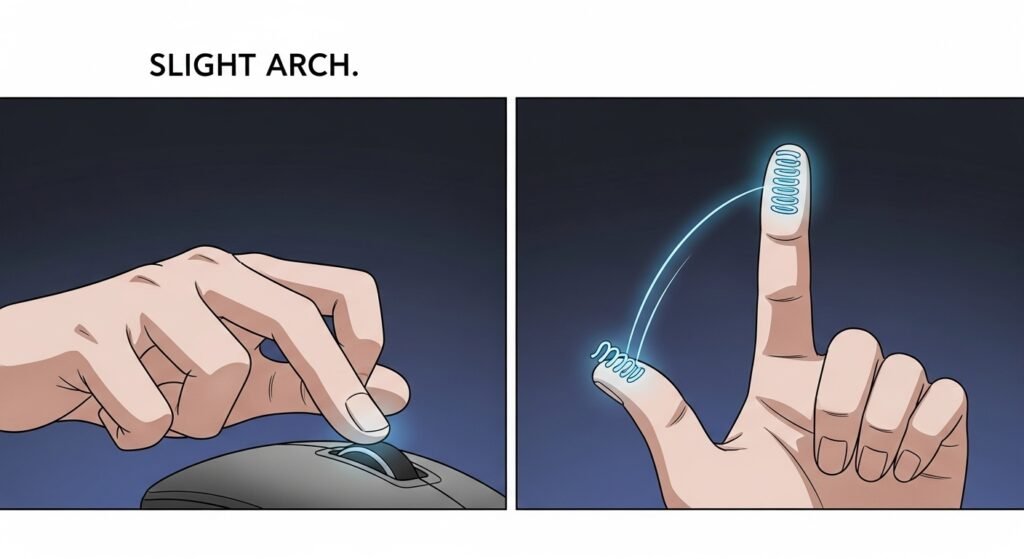
This is where the magic happens. We are now going to break down the physical motions of butterfly clicking into simple, repeatable steps. Remember, the goal is not to use brute force. The key to this technique is rhythm, relaxation, and finding the sweet spot on your mouse. Don’t worry if it feels clumsy at first—that’s a normal part of building new muscle memory. Follow these steps closely, and you’ll have a solid foundation to build upon.
Step 1: The Foundation – Finding the Perfect Grip and Hand Position
Before you even think about clicking, your grip must be correct. A tense or unstable hand is the number one killer of speed.
- Adopt a Relaxed Claw Grip: Do not rest your entire palm flat on the mouse. Instead, let the back of your palm rest lightly on the very end of the mouse.
- Arch Your Fingers: Your index and middle fingers should be arched upwards, like a claw. This allows them to move independently and quickly.
- Anchor Your Hand: Your thumb, ring finger, and pinky should grip the sides of the mouse firmly but gently. They are your anchor, providing the stability your hand needs while the other two fingers are in motion. Your hand should feel stable, not squeezed.
Step 2: The Rhythm – Alternating Your Index and Middle Fingers
This is the core mechanic. It’s about creating a consistent, drumming motion.
- Place Both Fingers: Rest both your index and middle fingertips lightly on the left mouse button. They should be side-by-side.
- Start Slowly: Begin by deliberately tapping the button, alternating between your fingers: Index, Middle, Index, Middle. Don’t worry about speed. Focus only on creating a clean, even rhythm.
- Keep it Light: The motion should be small and light. Your fingertips should barely lift off the surface of the button between clicks. The lighter your touch, the faster you’ll eventually be able to go.
Step 3: Finding the Sweet Spot on Your Mouse Button
Where you click on the button matters. You are not aiming for the center. The sweet spot is usually on the far left or right edge of the main mouse button. This is because hitting the edge can cause the switch to vibrate or chatter more easily, helping to induce double clicks.
Experiment by shifting your fingers slightly. Try clicking on the very front edge, then the side. You are listening and feeling for the spot where the clicks feel the lightest and require the least amount of effort. Finding this spot can instantly boost your speed. A quick way to test different spots is by using a one-second click test to see where you get the highest score in a short burst.
Step 4: Your First Test – Measuring Your Starting CPS
Now it’s time to put it all together. With your relaxed grip and your two fingers positioned over the sweet spot, you’re ready to see where you stand.
Go to a reliable tool to check your CPS. Perform the butterfly clicking motion for 5 to 10 seconds, focusing on maintaining a steady rhythm. Don’t be discouraged if your score is only 8 or 10 CPS. This is your baseline. The goal of this first test is not to be a pro, but to get a starting number that you can watch climb as you practice the drills in the next section.
Of course. You’ve learned the basic motion. Now, the real work begins: turning that awkward, clumsy drumming into a consistent, reliable skill.
From Clumsy to Consistent: Your First Two Weeks of Practice
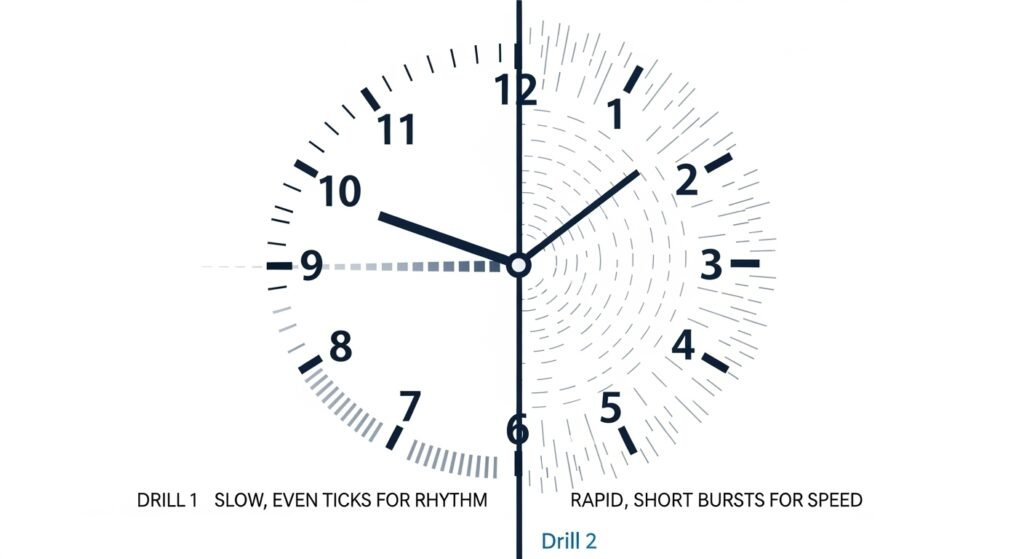
Knowing the steps is one thing; building the muscle memory is everything. The next two weeks are crucial for your development. The goal is not to become a pro overnight but to make the butterfly clicking motion feel as natural as a normal click. Consistency is your greatest weapon here. A focused 10-15 minutes of practice every day will yield far better results than one exhausting two-hour session on the weekend.
Drill 1: The Rhythm Builder (Slow, deliberate alternating clicks)
Your first priority is to perfect the rhythm. Speed will come later, but only if the foundation is flawless. This drill is designed to build that perfect 1-2-1-2 muscle memory.
- Open up a simple click counter so you can get visual feedback that your clicks are registering.
- Place your fingers in the butterfly position and begin clicking as slowly as you can while maintaining a perfectly even rhythm.
- Focus entirely on the feeling of the motion. Your goal is for each click to feel and sound identical.
- Do this for 3-5 minutes at the beginning of every practice session. Think of it as a warm-up. You are teaching your fingers to dance, not to fight.
Drill 2: The Speed Burst (5-second max-effort tests)
Once your fingers are warmed up with the rhythm drill, it’s time to push your speed in short, controlled bursts. This helps train your nervous system to fire more quickly without building bad habits.
- Navigate to a short-duration test. The best tool for this is a CPS test for 5 seconds, as it’s long enough to measure your speed but short enough to prevent fatigue.
- Perform a max-effort attempt, going as fast as you can while trying to maintain the rhythm.
- Rest for at least 30 seconds. Shake out your hand and let it relax completely.
- Repeat this process 5-10 times.
This drill is about pushing your limits. Don’t worry if your rhythm gets a little sloppy. The goal is to see how fast you can go, then dial it back to find a speed that is both fast and controlled.
The Most Common Beginner Mistake (And How to Fix It Instantly)
Nearly every beginner makes the same mistake: they tense up their entire hand and wrist. In an effort to go faster, they tighten their grip, flex their forearm, and try to power through it. This is a complete disaster. It kills your stamina, destroys your aim, and actually makes you slower because a tense muscle cannot move as quickly as a relaxed one.
The fix is simple but requires conscious effort: focus on keeping your wrist completely loose. The butterfly clicking motion should come entirely from your fingers. Your wrist and arm are just there to support and aim the mouse. If you feel your hand starting to cramp or your wrist getting tight, stop. Take a breath, shake out your hand, and restart, focusing only on the light, drumming motion of your two fingers. This single change is often the breakthrough that takes players from a clumsy 10 CPS to a smooth 16+ CPS.
Of course. Now that you’re building speed and consistency, it’s time to address the most important part of this entire guide: understanding the risks.
The Big Risks: Mouse Damage, Bans, and Hand Health
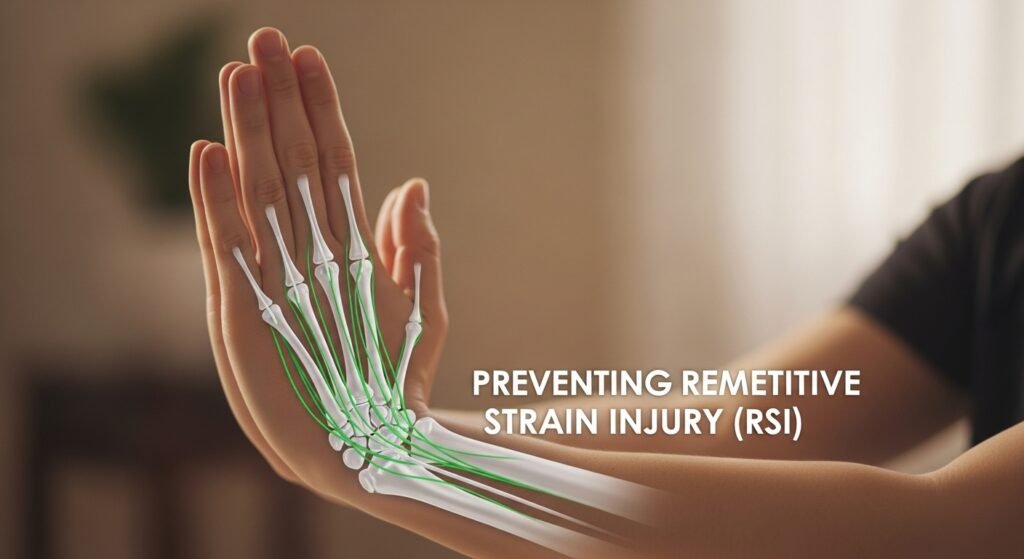
The immense power of butterfly clicking comes at a price. This is an extreme performance technique, and pushing your hardware and your body to such limits carries inherent risks that every player must understand and respect. Ignoring these warnings can lead to a broken mouse, a frustrating server ban, or—worst of all—a painful, long-term injury. Being a pro isn’t just about being fast; it’s about being smart and sustainable.
A Brutal Truth: How Butterfly Clicking Can Destroy Your Mouse Switches
Your mouse buttons are not invincible. Inside each button is a small mechanical switch, and these components are rated for a specific number of clicks before they are expected to fail. A high-quality gaming mouse might be rated for 50 million clicks. While that sounds like a lot, butterfly clicking burns through that lifespan at an alarming rate.
Think about it: A few hours of intense gaming can add tens of thousands of clicks to your mouse’s life. This accelerated wear can cause the switch to fail completely or, more commonly, develop a permanent hardware double-click issue. This is why it’s so important to regularly check your mouse’s performance with an ultimate double-click test. If it starts registering double clicks during normal use, it’s a clear sign of wear. Reputable hardware review sites often discuss switch durability, with many explaining that these high click ratings from manufacturers like Omron or Kailh are tested under ideal, not high-impact, conditions.
The Ergonomics of Speed: 3 Essential Stretches to Prevent Hand Strain
Your hand is not a machine. It’s a complex collection of bones, muscles, and tendons. The repetitive, high-frequency motion of butterfly clicking can cause significant strain if you don’t take preventative measures. These three simple stretches, performed before and after each gaming session, can dramatically reduce your risk of injury.
- The Prayer Stretch: Press your palms together in front of your chest as if in prayer. Slowly lower your hands towards your waistline, keeping your palms together, until you feel a gentle stretch in your wrists and forearms. Hold for 20-30 seconds.
- The Wrist Extensor Stretch: Extend your arm in front of you with your palm facing down. With your other hand, gently bend your wrist, pulling your fingers toward your body. Hold for 20-30 seconds to stretch the top of your forearm.
- The Finger Fan: Open your hand and stretch your fingers out as wide as you can, like a fan. Hold for five seconds, then make a gentle fist. Repeat this 5-10 times to improve circulation and tendon mobility.
Is Butterfly Clicking Cheating? A Deep Dive into Server Rules (Hypixel & More)
This is the question every competitive player asks. The short answer is: No, butterfly clicking itself is not considered cheating and is not a bannable offense on major servers like Hypixel. It is a physical skill that does not involve any third-party software or macros.
However, the situation is more complicated than that. Many servers use automated anti-cheat systems (like Watchdog) that monitor for inhumanly high click speeds. Because butterfly clicking—especially on a mouse that double-clicks easily—can produce a CPS of 20 or higher, it can sometimes trigger these systems and result in a false ban. The server’s software can’t tell the difference between a skilled player with a good mouse and a cheater using an auto-clicker. While the technique is legal, pushing it to its absolute limits carries a real risk of being flagged. This is why some players use it strategically, rather than constantly. This is a risk shared by other techniques, like those measured on the drag click test, which can also produce extremely high CPS values.
Frequently Asked Questions (FAQ)
You’ve learned the technique, the drills, and the risks. But a few specific questions are likely still on your mind. Here are the direct, no-nonsense answers to the most common queries about the art of butterfly clicking.
What is a good CPS for butterfly clicking?
Can you get banned for butterfly clicking?
Does butterfly clicking cause carpal tunnel?
Can you butterfly click on any mouse?
Is butterfly clicking better than drag clicking for PvP?
Conclusion
You now have the complete blueprint. We’ve journeyed from understanding the basic two-finger drumming motion of butterfly clicking to mastering the specific practice drills and identifying the essential gear needed for success. You know that incredible click speed isn’t some unobtainable magic; it’s a physical skill built on a foundation of rhythm, relaxation, and smart, consistent practice. The line between being a good player and a great one often comes down to mastering these advanced mechanical skills, and you are now fully equipped to start that journey.
Remember that PvP duel from the beginning? The one where you were overwhelmed by an opponent’s impossible speed? That scenario no longer has to be your reality. The relentless, drumming sound of victory is now a technique you can learn and perfect. Your very next step isn’t to hit 20 CPS overnight. It’s to simply place your hand on your mouse, find that comfortable two-finger grip, and start practicing the slow, deliberate rhythm. The path to mastery begins with that first, simple motion.
What’s the first game you’ll dominate with your new click speed?

Hello, I’m John Harbour, a software developer passionate about creating innovative and accessible AI tools. As the creator of cps-checker.com, I enjoy building useful software and writing blogs to help people get the most out of my creations.

